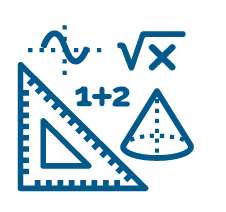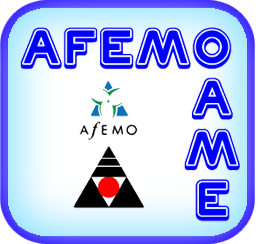

Grade 9 Resources
 Ontario Mathematics Curriculum, 2021, Grade 9
[URL]
Ontario Mathematics Curriculum, 2021, Grade 9
[URL]
This curriculum policy replaces The Ontario Curriculum, Grade 9: Mathematics, 2005. Beginning in September 2021, all mathematics programs for Grade 9 will be based on the expectations outlined in this curriculum policy.
Sample Course Plan (Option 1) created by the OAME/AFEMO project team for Grade 9 Mathematics, 2021, and organized by Applications of Concepts. This course plan has the overall and specific expectations of MTH1W organized into ten (10) questions.
Sample Course Plan (Option 2) created by the OAME/AFEMO project team for Grade 9 Mathematics, 2021, and organized by Questions and Topics. This course plan has the overall and specific expectations of MTH1W organized into five units.
Sample Course Plan (Option 3) created by the OAME/AFEMO project team for Grade 9 Mathematics, 2021, and organized by Clusters. This course plan has the overall and specific expectations of MTH1W organized into four clusters.
Students in Ontario are navigating a complex world driven by data. Our world is evolving and new fields and careers are emerging that require individuals with high levels of data literacy. Supporting students as they develop critical data literacy skills is an essential component of the new de-streamed Grade 9 curriculum. Data literacy is different from data management. Certainly, data management skills are important to analyse data. As part of the revised elementary mathematics curriculum in 2020, students have been building their data management skills. How do we connect these with the larger goal of achieving data literacy? What are the competencies necessary for data literacy, and how will we continue to build these competencies to ensure that all students leave our schools as data literate young adults? In this webinar, we will talk more about these competencies, and we will share strategies for integrating data literacy into the teaching of each of the math strands.
Students will use number sense (e.g., percentages, rates, ratios, conversions) to modify a budget for various circumstances.
This lesson introduces students to the concepts of limits and infinity through the lens of a practical geometry and measurement problem and through the use of coding and spreadsheets. Students will begin with a practical problem, then investigate, in a theoretical way, how increasing the number of sides of a regular polygon, while holding the perimeter fixed, influences the area of the polygon. They will create a pattern of polygon area calculations that tends to the largest area, a circle, by adding smaller and smaller increments. Patterns will be examined using tables of values and graphs, with an end goal of students understanding that the area will approach a limiting value. Students will then apply this new knowledge to the original practical problem.
Looking at data around us, such as sports statistics and news reports, students will explore different ways to represent, analyse, and understand data, including quartile values and box plots.
This lesson allows students to see how the way visual patterns are growing can be interpreted in different ways and how each different way connects to an algebraic representation. They will then learn how to show that all the representations are equivalent.
This lesson introduces students to the concept of density as it relates to the rational numbers, while also exploring patterns with fractions and powers through the lens of an Imperial ruler.
In this lesson, students will use Canadian CO2 Emissions Data to determine trends and make predictions for the future - if nothing is done and if we adopt emissions reduction strategies.
This lesson introduces students to some of the basic algebraic skills that will be used in this and future courses. Students will use CAS (Computer Algebra Systems) to test a variety of operations and look for patterns and determine algebraic properties. Then students will use code to test the properties, as well as to modify existing code to observe different properties. Throughout the lesson, students will identify and utilize resources and supports that aid in perseverance in mathematical learning and develop critical mathematical thinking.
Through an exploration of Aesop’s Fable, the Crow and the Pitcher, students will use algebra and coding to solve problems involving measurement and, in doing so, will develop problem-solving strategies. To simulate the story told in the fable, students will gather data, and will later develop an algebraic model and test their model. Students will consolidate strategies for problem solving. Finally, they will test their strategies with a new dunk tank challenge.
Students will extend their understanding of the use of large-scale national data sets by examining data sets at a specific moment in time and over a range of time to understand how each data set can be used to help guide government decisions and policy-making. Furthermore, they will examine how the data could potentially be misused. Students will also examine issues around the collection and storage of large-scale data. Students will have an opportunity to explore data on a topic of their choice based on their interests within the Statistics Canada database.
Video games are packed with data. This lesson uses data that is available for Minecraft to demonstrate how a player can use data and mathematics to inform their choices so as to make good decisions while playing video games.
In this lesson, students will identify linear and non-linear relationships in a variety of contexts. Students will determine characteristics of linear and non-linear relationships in multiple representations. (Students should have completed the How’s it Growing lesson prior to this one.)
This lesson allows students to explore how changing one or more dimensions in a 2D shape affects perimeter/circumference and/or area, and how changing one or more dimensions in a 3D object affects surface area and/or volume. Students will use coding to gain further understanding of these concepts, allowing them to explore a greater breadth of examples during the lesson.
This lesson allows students to represent linear relations using concrete materials, tables of values, graphs, and equations, and make connections between the various representations to demonstrate an understanding of rates of change and initial values.
Students will count the number of steps required to travel a given distance, such as a lap, and then analyze and graphically represent their data.
In this lesson, students will be working with fractions, decimals, percentages, rates, and proportions to solve problems involving measurement, geometry, and trajectory. Small errors in inputs can create large and unintended consequences in the outputs. While estimation is often useful, in some situations, precision is of critical importance.
This lesson introduces students to relations of the form x + y = k, 2x + 2y = k and xy = k and uses these graphs as a platform to explain infinity and density. Throughout the lesson students will create graphs, both by hand and using technology, and will strengthen their understanding of how to use lines and/or curves of best fit to uncover information about the relation.
This lesson uses data collection and analysis to draw conclusions and raise awareness about the benefits of good mental health.
In this lesson, students will discover the relationship between the volume of prisms and pyramids and the relationship between the volume of cylinders and cones through cardboard constructions and class discussions.
In this lesson, students will learn, with a partner, a concept under consideration and become the experts on that concept. Each team will then be invited to explain their concept to the other teams in a carousel format. By the end of this lesson, all students will have learned six new basic concepts: understanding number development, evaluating powers, solving equations, understanding the development and use of geometric relationships, analyzing data, and understanding the characteristics of various representations. It is suggested that this lesson be done early in the course.
In this lesson, students examine the effect of various factors, such as interest rate, initial cost and down payment amount, on the total cost of a loan for a large expense.
This lesson will explore the connections between ratios, proportions, fractions, percentages, decimals, and slope through an investigation of the Vitruvian Man painting by Leonardo DaVinci. Students will use different tools, including tape measures, spreadsheets, and graphing technology to collect data, graph relationships, and develop an understanding of regression. This lesson builds on, and incorporates, students’ prior knowledge of scatter plots, weak to strong relationships between variables, outliers, and lines of best fit.
This lesson gives students a chance to develop their research skills by working in groups to investigate the history of fractions. By completing this scaffolded lesson, students will be more prepared to engage in individual research on a mathematical concept of their choice.
This lesson provides students with information about a sample budget. Students will be given a variety of different situations that may include deductions, housing costs, and costs related to daily/monthly life, all used to modify a budget. Throughout the lesson, students will build healthy relationships and communicate effectively in mathematics, as well as develop critical mathematical thinking.
This lesson exposes students to different ways that money can grow and some of the risks associated with winning large sums of money. This lesson pairs well with the Healthy Living strand of the Grade 9 Physical Education curriculum. This lesson can be used before lessons ""Let’s Go on an Adventure!"" and ""A Future Year in the Life of a Student - Making Financial Decisions"", both of which deal with creating budgets.
Students will make connections between algebraic models of linear equations and their representations (graph/table of values/pattern), and describe the effect of the representations when an equation is manipulated or changed in different ways.
Students will make connections between algebraic models of linear equations and their representations (graph/table of values/pattern), and describe the effect of the representations when an equation is manipulated or changed in different ways.
This webinar will introduce Ontario educators to three (3) course plans, each of which outlines a different way a teacher could structure the 2021 Grade 9 math course. These course plans have been shared on our OntarioMath.support website. Each course plan includes all of the curriculum expectations, providing suggestions as to how to group expectations to present mathematics in Grade 9 as a connected whole. In addition to providing ways to structure the course, each plan offers ideas for questions and tasks that will engage students with the mathematics they are learning. In this webinar, we will also outline the underlying principles upon which all three course plans have been designed to provide support for teachers as they implement a de-streamed grade 9 curriculum.
How are de-streamed classrooms different? How must instruction and assessment be shifted to accommodate these differences? In this webinar, we will talk about the goal of ensuring success for ALL our students, as well as considerations and ideas that will support teachers as they plan their math programs.
Creating a safe and inclusive learning environment, one that encourages student collaboration and student choice, is critical to successfully implementing the 2021 de-streamed mathematics program. In this webinar, we will share practical strategies for meeting the challenges of teaching this new curriculum while ensuring equity and inclusivity, bringing student voice and student lived experiences into the mathematics learning.
This hour-long webinar will focus on how the process of Mathematical Modelling, integrated with Grade 9 math concepts, can effectively support student development of strong mathematical thinking skills. In this webinar, we will explore in detail what the mathematical modelling process looks like and how it naturally builds connections between math and other disciplines, as well as between math and students' own cultures and communities. We hope to deepen educators’ understanding of what Mathematical Modelling is and how it can be woven into a math program. Sample tasks will be discussed.
“In Grade 9, students transition to using coding as a tool to interact with the mathematics they are learning. They use the skills developed in elementary to create and alter code in a multitude of coding environments including text-based programming languages, spreadsheets, computer algebra systems (CAS), and virtual graphing and geometry tools.” (2021 MTH1W) What do students know about coding coming into Grade 9? How am I supposed to teach coding as well as all the other math expectations? How can I support students when I don’t know how to code? If you’ve asked yourself some of these questions, come to this webinar to explore some answers.
August 2021
In this webinar about the transition from the revised elementary mathematics curriculum (2020) to the newly revised Grade 9 mathematics curriculum (2021), participants will receive specific information about the alignment of expectations for grades 7, 8, and 9. They will also receive guidance on approaches to course planning as well as lesson and assessment planning. References and resources available to support teachers will be shared. A Question and Answer period will be included in this webinar.











































